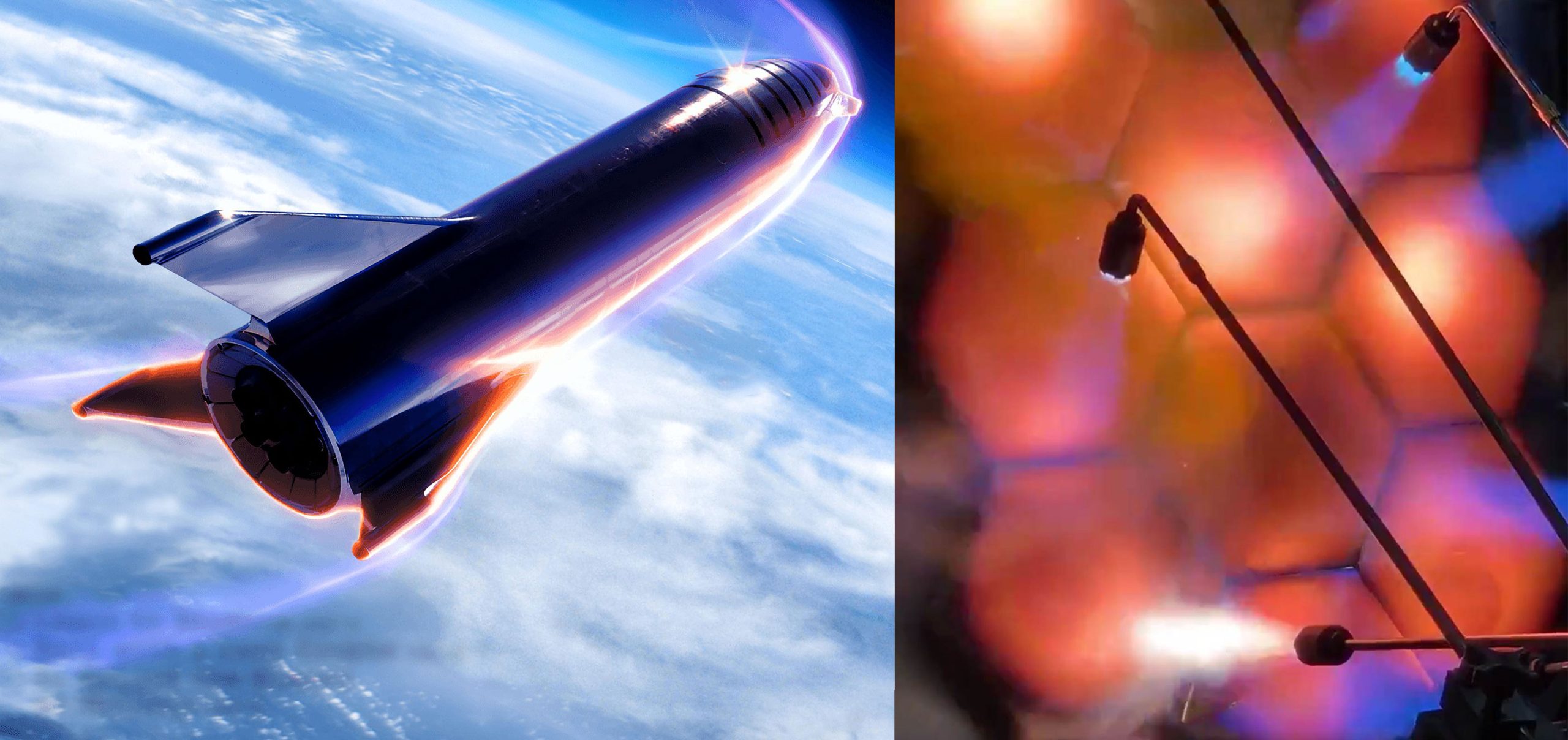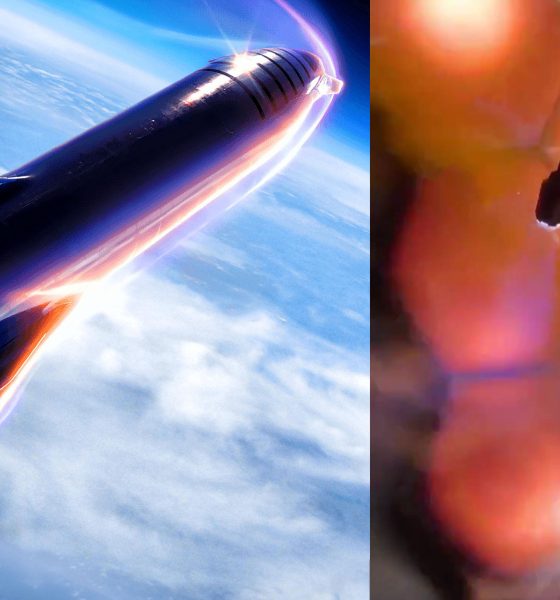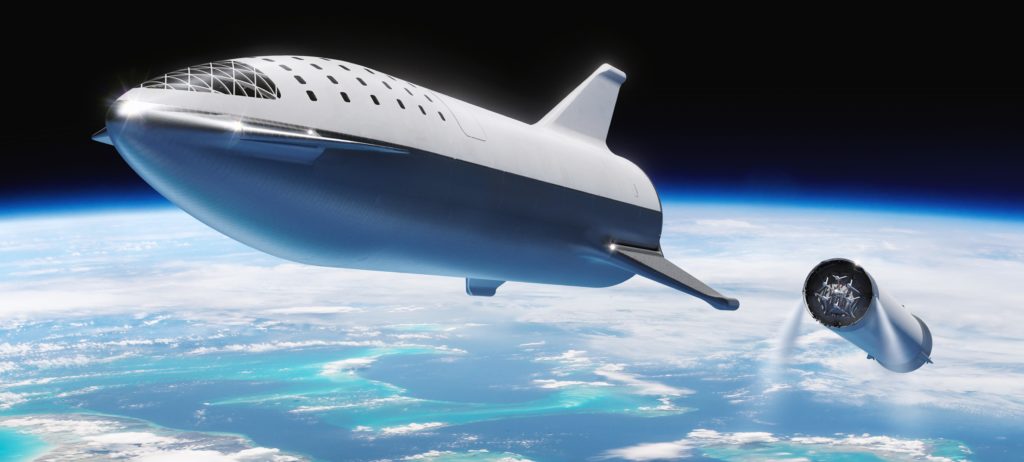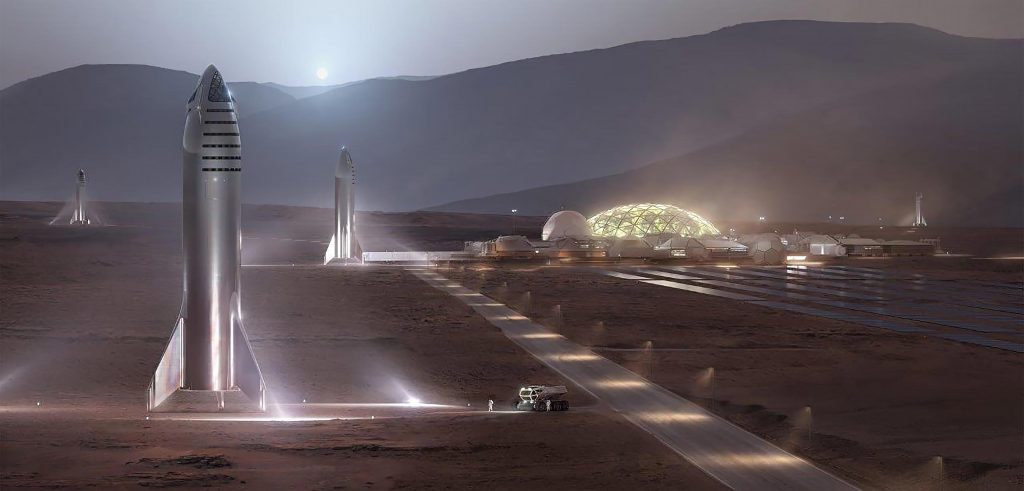

News
SpaceX CEO Elon Musk hints that Starship’s ‘sweating’ metal heat shield is no more
In the latest entry of SpaceX’s ever-changing Starship design process, CEO Elon Musk has indicated that the nominally reusable orbital spacecraft has moved away from a liquid-cooled steel heat shield to something slightly more traditional.
This information came as a SpaceX engineer announced during Cargo Dragon’s CRS-18 webcast that the twice-flown spacecraft would mark the first orbital test of a ceramic heat shield tile meant for use on Starship’s windward side. This major design change comes as a significant surprise and seems likely to either delay Starship’s orbital debut or hinder its ultimate reusability, although Musk just as recently claimed that the spacecraft could reach orbit for the first time less than six months from now.
Testing a possible Starship windward side ceramic tile. Maximizing emissivity is best for conductive/particle heating. Nice thing about steel is that tiles can be very thin, unlike carbon fiber or aluminum airframe.— ln(e) (@elonmusk) July 25, 2019
Thin tiles on windward side of ship & nothing on leeward or anywhere on booster looks like lightest option— ln(e) (@elonmusk) July 25, 2019
Back in late-2018 and early-2019, Musk took to Twitter to announce that SpaceX was pursuing an exotic metallic heat shield that would be cooled in large part by flowing liquid methane through tiny holes on its exterior, effectively ‘sweating’ away energy and preventing steel tiles from melting.
Despite incontrovertible evidence that SpaceX performed some amount of significant testing on the hexagonally-tiled steel heat shield concept, Musk’s July 24th tweets indicate that the liquid-cooled heat shield is unlikely to ever be used on Starship. For unknown reasons, SpaceX is instead pursuing some sort of thin ceramic heat shielding to protect the entirety of Starship’s windward side (i.e. the side facing the atmosphere during reentry). A handful of the first flight-qualified ceramic tiles – shaped for Dragon instead of Starship – will be tested on Cargo Dragon during the spacecraft’s orbital mission and eventual reentry.
Of note, this is not the only major design change Starship has undergone in just the last few months. Speaking on May 30th, Elon Musk stated that the design of Starship’s landing legs/fins and actuating wings and flaps has changed significantly since SpaceX revealed the new tripod fins + canard wings configuration in September 2018. According to Musk, that change will (or at least should) not significantly impact Starship’s schedule.

In fact, per his July 2019 claims that the first full-fidelity Starship prototype(s) could begin test flights in September/October and reach orbit as early as December/January, the Starship/Super Heavy schedule has actually radically sped up in the first half of 2019. In December 2018, Musk stated that he believed Starship had a 60% chance of reaching orbit in 2020, let alone late-2019.
For Starship, the massive spacecraft’s heat shield is arguably its single most important component. A failure to ensure that the heat shield is unprecedentedly reusable and reliable – even in the face of ultra-high-velocity interplanetary reentries – will severely limit Starship’s ability to achieve its ultimate goals of enabling affordable access to space and building a sustainable city on Mars. Musk’s comment that ceramic tiles are just “a possible” Starship heat shield element further indicates that SpaceX has yet to firmly settle on a heat shield design, let alone qualify said shield for orbital flight or kick off the mass-production necessary to completely cover multiple Starship halves.

Admittedly, there is still some good news in this unfortunate development. Most notably, the fact that Starship will still be made of steel means that the non-metallic heat shield tiles can be extremely thin and light, as they can be more or less directly attached to Starship’s steel hull. Additionally, steel Super Heavy boosters may be able to get away with zero heat shielding thanks to the relatively high melting point and heat resistance of certain varieties of stainless steel.
So long as both of those characteristics remain true, it’s likely that it will still make sense for Starship/Super Heavy to be built entirely out of steel instead of something like aluminum or carbon composite. With any luck, Elon Musk will provide a detailed update on the status of SpaceX’s next-generation launch vehicle soon after Starhopper survives its first untethered flight test.
Check out Teslarati’s Marketplace! We offer Tesla accessories, including for the Tesla Cybertruck and Tesla Model 3.

News
Tesla aims to combat common Full Self-Driving problem with new patent
Tesla writes in the patent that its autonomous and semi-autonomous vehicles are heavily reliant on camera systems to navigate and interact with their environment.

Tesla is aiming to combat a common Full Self-Driving problem with a new patent.
One issue with Tesla’s vision-based approach is that sunlight glare can become a troublesome element of everyday travel. Full Self-Driving is certainly an amazing technology, but there are still things Tesla is aiming to figure out with its development.
Unfortunately, it is extremely difficult to get around this issue, and even humans need ways to combat it when they’re driving, as we commonly use sunglasses or sun visors to give us better visibility.
Cameras obviously do not have these ways to fight sunglare, but a new patent Tesla recently had published aims to fight this through a “glare shield.”
Tesla writes in the patent that its autonomous and semi-autonomous vehicles are heavily reliant on camera systems to navigate and interact with their environment.

The ability to see surroundings is crucial for accurate performance, and glare is one element of interference that has yet to be confronted.
Tesla described the patent, which will utilize “a textured surface composed of an array of micro-cones, or cone-shaped formations, which serve to scatter incident light in various directions, thereby reducing glare and improving camera vision.”

The patent was first spotted by Not a Tesla App.
The design of the micro-cones is the first element of the puzzle to fight the excess glare. The patent says they are “optimized in size, angle, and orientation to minimize Total Hemispherical Reflectance (THR) and reflection penalty, enhancing the camera’s ability to accurately interpret visual data.”
Additionally, there is an electromechanical system for dynamic orientation adjustment, which will allow the micro-cones to move based on the angle of external light sources.
This is not the only thing Tesla is mulling to resolve issues with sunlight glare, as it has also worked on two other ways to combat the problem. One thing the company has discussed is a direct photon count.
CEO Elon Musk said during the Q2 Earnings Call:
“We use an approach which is direct photon count. When you see a processed image, so the image that goes from the sort of photon counter — the silicon photon counter — that then goes through a digital signal processor or image signal processor, that’s normally what happens. And then the image that you see looks all washed out, because if you point the camera at the sun, the post-processing of the photon counting washes things out.”
Future Hardware iterations, like Hardware 5 and Hardware 6, could also integrate better solutions for the sunglare issue, such as neutral density filters or heated lenses, aiming to solve glare more effectively.
Elon Musk
Delaware Supreme Court reinstates Elon Musk’s 2018 Tesla CEO pay package
The unanimous decision criticized the prior total rescission as “improper and inequitable,” arguing that it left Musk uncompensated for six years of transformative leadership at Tesla.

The Delaware Supreme Court has overturned a lower court ruling, reinstating Elon Musk’s 2018 compensation package originally valued at $56 billion but now worth approximately $139 billion due to Tesla’s soaring stock price.
The unanimous decision criticized the prior total rescission as “improper and inequitable,” arguing that it left Musk uncompensated for six years of transformative leadership at Tesla. Musk quickly celebrated the outcome on X, stating that he felt “vindicated.” He also shared his gratitude to TSLA shareholders.
Delaware Supreme Court makes a decision
In a 49-page ruling Friday, the Delaware Supreme Court reversed Chancellor Kathaleen McCormick’s 2024 decision that voided the 2018 package over alleged board conflicts and inadequate shareholder disclosures. The high court acknowledged varying views on liability but agreed rescission was excessive, stating it “leaves Musk uncompensated for his time and efforts over a period of six years.”
The 2018 plan granted Musk options on about 304 million shares upon hitting aggressive milestones, all of which were achieved ahead of time. Shareholders overwhelmingly approved it initially in 2018 and ratified it once again in 2024 after the Delaware lower court struck it down. The case against Musk’s 2018 pay package was filed by plaintiff Richard Tornetta, who held just nine shares when the compensation plan was approved.
A hard-fought victory
As noted in a Reuters report, Tesla’s win avoids a potential $26 billion earnings hit from replacing the award at current prices. Tesla, now Texas-incorporated, had hedged with interim plans, including a November 2025 shareholder-approved package potentially worth $878 billion tied to Robotaxi and Optimus goals and other extremely aggressive operational milestones.
The saga surrounding Elon Musk’s 2018 pay package ultimately damaged Delaware’s corporate appeal, prompting a number of high-profile firms, such as Dropbox, Roblox, Trade Desk, and Coinbase, to follow Tesla’s exodus out of the state. What added more fuel to the issue was the fact that Tornetta’s legal team, following the lower court’s 2024 decision, demanded a fee request of more than $5.1 billion worth of TSLA stock, which was equal to an hourly rate of over $200,000.
Delaware Supreme Court Elon Musk 2018 Pay Package by Simon Alvarez
News
Tesla Cybercab tests are going on overdrive with production-ready units
Tesla is ramping its real-world tests of the Cybercab, with multiple sightings of the vehicle being reported across social media this week.

Tesla is ramping its real-world tests of the Cybercab, with multiple sightings of the autonomous two-seater being reported across social media this week. Based on videos of the vehicle that have been shared online, it appears that Cybercab tests are underway across multiple states.
Recent Cybercab sightings
Reports of Cybercab tests have ramped this week, with a vehicle that looked like a production-ready prototype being spotted at Apple’s Visitor Center in California. The vehicle in this sighting was interesting as it was equipped with a steering wheel. The vehicle also featured some changes to the design of its brake lights.
The Cybercab was also filmed testing at the Fremont factory’s test track, which also seemed to involve a vehicle that looked production-ready. This also seemed to be the case for a Cybercab that was spotted in Austin, Texas, which happened to be undergoing real-world tests. Overall, these sightings suggest that Cybercab testing is fully underway, and the vehicle is really moving towards production.
Production design all but finalized?
Recently, a near-production-ready Cybercab was showcased at Tesla’s Santana Row showroom in San Jose. The vehicle was equipped with frameless windows, dual windshield wipers, powered butterfly door struts, an extended front splitter, an updated lightbar, new wheel covers, and a license plate bracket. Interior updates include redesigned dash/door panels, refined seats with center cupholders, updated carpet, and what appeared to be improved legroom.
There seems to be a pretty good chance that the Cybercab’s design has been all but finalized, at least considering Elon Musk’s comments at the 2025 Annual Shareholder Meeting. During the event, Musk confirmed that the vehicle will enter production around April 2026, and its production targets will be quite ambitious.








